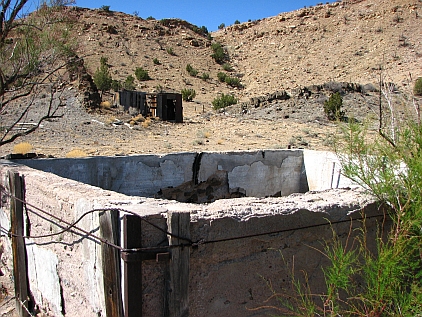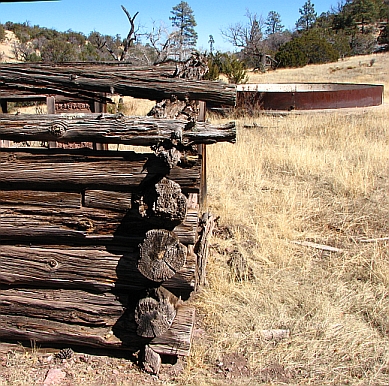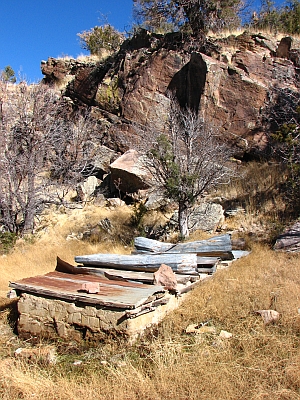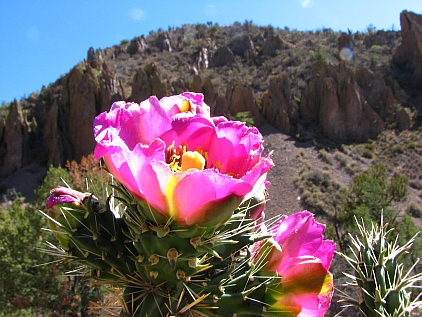Water works
The main water works described on this page are graywater reuse and rainwater harvesting and storage. Management of run-on stormwater is described on the Land forming page.
Graywater
Graywater use principles
Why reuse graywater?
Because it saves drinking water, in applications where drinking-quality water isn't needed. It can be used to flush toilets, wash cars, or irrigate plants.
In New Mexico, as in Arizona, graywater reuse laws are permissive and sensible; a summary can be found in the State Engineer's publication about household graywater reuse and another in a second publication by the State Engineer. As long as you have some approved sanitary way to dispose of possible overflow from your graywater system—such as into a conventional septic system or sewer—your system will be acceptable. Kitchen sink wastewater is considered blackwater, not graywater, and shouldn't be disposed of in your graywater system. Tub, shower, and basin water from your bathroom and washwater from your laundry room are your main graywater components. Water from dishwashers and evaporative coolers should be handled separately, as it's too salty for use on plants. Never store graywater. The organic materials in it will quickly start rotting and you'll have liquid that smells like sewage.
You aren't encouraged to water lawns with graywater, as it contains solids that can accumulate on top of the ground. Nor are you supposed to water a vegetable garden with it, although it's unlikely anyone will get sick from traces of washwater residue on vegetables. The best use for it is to run it under mulch around trees and shrubs. Soil organisms will quickly dispose of the solids.
Don't use ordinary soaps and detergents in water that you'll be watering plants with. They have too much sodium and salt as well as surfactants, perfumes, and other chemicals that plants don't need or like. There are several potassium-based liquid soaps (I use Oasis) that do a perfectly good job washing clothes—even in cold water— and bodies.
How to collect graywater
Are you thinking you have to shower over a bucket, or wash your clothes in a washtub, and then haul the water outside? Most people—including me—don't have time or energy for such laborious measures. The most convenient way to collect graywater is to modify your plumbing so that, without any effort, you can send your wastewater out through the house wall to a hose or pipe that distributes it to your plants. You want to use a three-way valve so that in the winter or any other time when you don't need any water out there, you can send it down your sewer or septic system. If your bathroom plumbing is buried under a concrete slab, you may be out of luck. But quite often laundry rooms have exterior walls and their drains can be diverted to the outside. See Art Ludwig's site and books for plenty of details.
My graywater systems
In the main house and the cottage, it turned out that all the plumbing was accessible. The main house has a basement reached through an outside cellar door. Here's what we did.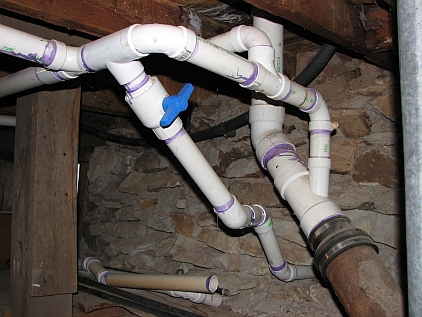
The sewer line runs down and to the right (that galvanized vertical pipe at right isn't part of the system). The bathroom stool sits above the sewer and is connected with 4' PVC. The drains from the tub and all the sinks come in the 2" pipe from the left. The diagonal 2" PVC pipe going out through the foundation (about 4" below grade) is our graywater line. It's joined to the drain line at the upper end by a blue valve, turned off because it was midwinter when the shot was taken. The kitchen sink wastewater is included in the graywater. Because I don't eat meat and don't put much food waste down the sink, I didn't separate them. But I may modify the system by running a bypass from that sink, for code compliance.
The laundry drain was already fed into an underground PVC pipe leading somewhere we never identified. We capped that (rather, the handyman I was employing did it) and ran the line to connect outside with the outlet line shown exiting through the foundation above. It's recommended that you keep graywater sources separate instead of joining them, but my water use is very light and I didn't want to have multiple hoses lying around outside.
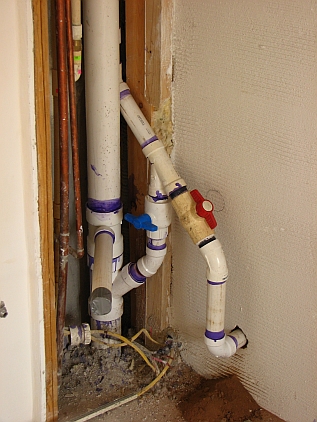
The cottage system wasn't much harder, though I paid a real plumber to do it. Here's what it looks like. We're looking at the SW corner of the kitchen. The 4" PVC pipe comes down from the stool and into the sewer line. The 1.5" line with tape over the end, coming toward the viewer, will be connected to the kitchen sink drain only a couple of feet away. The other 2" PVC line coming down from upstairs carries the tub, vanity, and washing machine wastewater, which used to go directly into the sewer line extending upstairs and we replumbed there. The line with the red valve goes out through the adobe wall and has a hose connection outside, for irrigation. To divert the water down the sewer in winter, we just open the blue valve and close the red one.
Rainwater collection
Why collect rainwater?
Because otherwise we're using water pumped out of the ground and treated to make it drinkable—even though most of our water doesn't need to be drinkable.
Irrigation, the biggest consumer of water in New Mexico, accounts for about 20% of the water use in Magdalena (shown by the warm-weather peaks in the consumption plot) and in dry regions like this hastens groundwater depletion. Even if we don't treat our collected rainwater to make it safe for drinking, we can use it for everything else—washing, bathing, irrigation. In Magdalena and elsewhere in the arid west, we'd better use the groundwater as lightly as we can. It's not going to last forever.
One resource that I didn't consult before doing any of this work would merit your attention: a publication of the NM State Engineer on roof-reliant landscaping.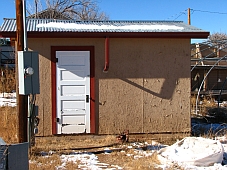
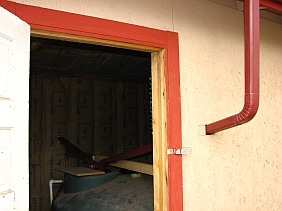
My property has a well, permitted for 3 acre-feet a year, but that's just nominal. The well produces only a few gallons before the pump kicks off, and I won't be using it for anything. The well house has a 1100-gallon water tank in it. Curiously enough, just putting gutters and downspouts on the roof of that little shed is enough to fill up the tank in a year when only 10" of precipitation falls.
In July and August I had all four buildings guttered—which involved our adding fascia boards to two of them and cutting back the Pro-Panel roofing edges on most of them. I also bought five tanks, one of 1100 gal and the others of 1550 or 1650 gal. These were opaque, being of dark green or black polyethylene, but we painted them for UV protection. The images below show, for four of them, how they were plumbed into the gutters.
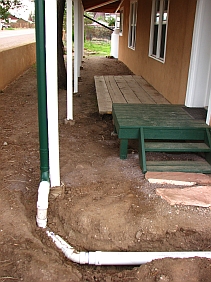
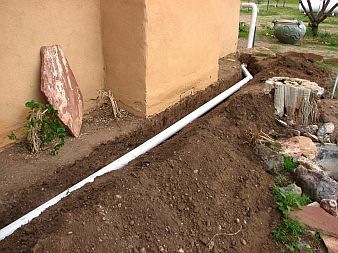
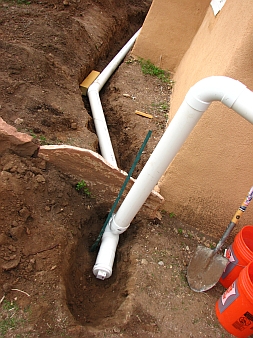
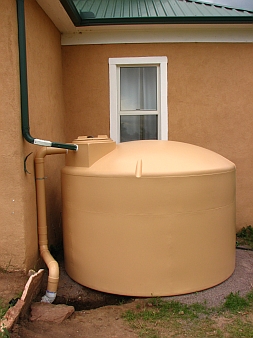
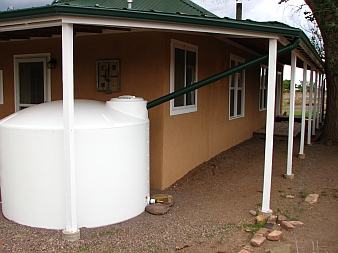
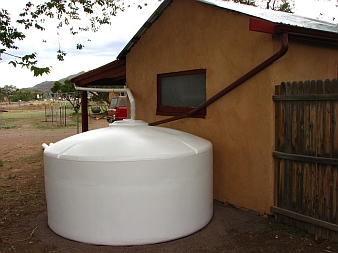
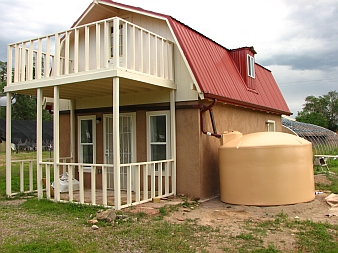
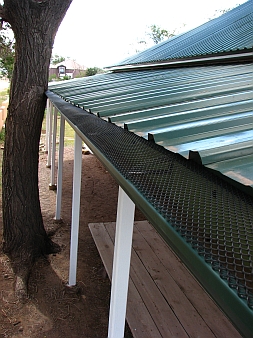
All of these tanks received enough rainwater to overflow in what remained of the monsoon season. Since I hadn't installed any overflow outlets, I had to go out and open the main outlets during the rainstorms—which wasn't much fun in the middle of the night.
The water in the plastic valves will freeze and split them, so the outlets should be well insulated in the winter. If the gutter receives leaves, install some gutter guard (shown above). But that tree is gone now.
Using stored rainwater
This water is low-pressure. But if the tank is full enough or high enough above your garden that you have a few feet of head, it will go through a drip line or a soaker hose. I just attach a garden hose to the outlet and run it into the garden or my tree basins.
I also use rainwater, carried in 5-gallon buckets, to fill my little washing machine in the warm season, saving 15 gallons of drinking water per wash (there's no way to get the water in for the rinse cycle). I could rig up a little pump to save the carrying, but it's a minor chore every few weeks.
Cost
The guttering cost $2700 for about 270 running feet. If doing it again, I'd forgo the seamless guttering and the professional installation and do it with one handyman for a lot less.
The tanks cost around $800 apiece, delivered, and the paint and painting cost probably $300. So the total for what's now 8600 gal of storage was around $7000.
Looked at economically only, is there any sense in such an investment, assuming that Magdalena wells never again fail and will support all the irrigation that residents wish to do? At current water rates, each household gets 2000 gallons per month for around $15—which is pretty cheap. I don't know what the rate is above that, but that means my 8600 gal are worth maybe $65 on the local water market. So the system might pay off the principal in 50 years—neglecting interest. If the tanks last that long, which they should (but I won't!), I've broken even.
The bigger reason for going to this expense is as a statement and as an example. Some people can't afford to install guttering and poly tanks at their private residences, especially in an economically depressed area like rural New Mexico. And I suspect that flat-screen TVs, smartphones, new pickup trucks, and other consumer goods are higher on most people's wish lists than taking personal responsibility for household and community water security. But just one tank isn't that costly, and will support several trees, especially if graywater is used to supplement the natural rainfall. Collectively we can't just keep looting a limited resource. Whatever it costs, we must find a way to live on the earth without destroying it.
Alternative storage systems
Poly tanks aren't the only way to store water. For larger volumes, open-top tanks made of stone, concrete, and/or steel can be found all over New Mexico being filled by windmill pumps, springs, or seasonal water flows. Here's an abandoned one near Riley, another near an old log cabin in the San Mateos foothills, and another, not far from a covered cistern, a few miles away.
